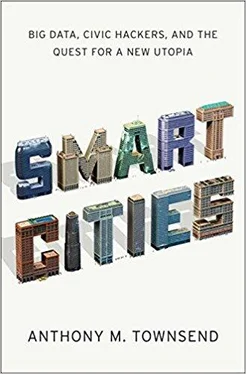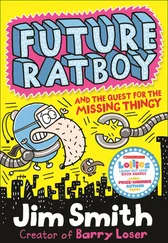What’s much more interesting is how we are going to change our technology to create the kinds of places we want to live in. I believe that’s going to happen at the grass roots, and I hope my vision of the tremendous resilience and potential for innovation in every city will carry you through the darker moments of this book. I think there is an important role for industry, but my objective here is to put an end to the domination of corporate visions in these early conversations about the future of cities.
Above all, I’m an advocate for cities and the people that live in them. Technology pundits can preach from behind a screen, but cities can’t be understood only by looking inside City Hall or a boardroom. You have to connect the schemes of the rich and powerful with the life of the street. That means taking a broad historical and global view of the landscape. To understand the choices we have ahead of us and the unintended consequences, and articulate a set of principles that can better guide our plans and designs moving forward, we need to reexamine how cities and information and communications technologies have shaped each other in the past.
We’re also going to skip around. A lot. There isn’t any single place we can go to see a smart city in its entirety—they are emerging in fits and starts all across the world. And some of the things we’ll see may not be here tomorrow. The smart city is a work in progress. Each day, we lay new wires and mount new antennas, load new software, and collect new data. By the time you read this, many of the technologies described in this book will have evolved. A few will be obsolete. New inventions will have taken their place.
Still, the struggle will remain. The technology industry is asking us to rebuild the world around its vision of efficient, safe, convenient living. It is spending hundreds of millions of dollars to convince us to pay for it. But we’ve seen this movie before. As essayist Walter Lippmann wrote of the 1939 World’s Fair, “General Motors has spent a small fortune to convince the American public that if it wishes to enjoy the full benefit of private enterprise in motor manufacturing, it will have to rebuild its cities and its highways by public enterprise.”40 Today the computer guys are singing the same song.
I believe there is a better way to build smart cities than to simply call in the engineers. We need to lift up the civic leaders who would show us a different way. We need to empower ourselves to build future cities organically, from the bottom up, and do it in time to save ourselves from climate change. This book shows you it can be done, one street corner at a time. If that seems an insurmountable goal, don’t forget that at the end of the day the smartest city in the world is the one you live in. If that’s not worth fighting for, I don’t know what is
1.The $100 Billion Jackpot
Throughout history, the construction of great gathering spaces has always pushed the limits of technology. Hie Crystal Palace, a vast, soaring structure of iron and glass built in London’s Hyde Park was no exception. The brainchild of Joseph Paxton, a master gardener and architect of greenhouses, the Crystal Palace was a stage for one of the most celebrated international expos of all time, the Great Exhibition of 1851. It was the architectural expression of Victorian England’s fast-growing industrial might.
But with industrial-scale architecture came industrial-scale management challenges. As new materials and advances in structural engineering permitted the construction of ever-larger buildings in the nineteenth century, it became more and more difficult to manage the growing flows of people, air, water, and waste that coursed through them each day. With all its glass, the Crystal Palace was, by Paxton’s design, a massive greenhouse. Without proper ventilation, the building would have simply cooked the 90,000 visitors its vast expanses could hold.
With the invention of modern air-conditioning still a half-century in the future, Paxton desperately needed a way to boost the building’s own natural ventilation. His solution was a system of louvered vents that ran along the buildings eaves, which could be opened to release rising hot air and draw in cooler air through the many ground-level entrances. Mechanical rods and levers were fastened into place linking the controls for multiple vents in 300-foot clusters, greatly reducing the labor involved in opening and closing them. Manned by a small team of attendants from the Royal Sappers and Miners, the British military’s engineering corps, the vents were adjusted every two hours based on readings from fourteen thermostats placed throughout the structure.1 While far from automatic, the Crystal Palace’s ventilation system showed how mechanical controls and sensors could work together to dynamically reconfigure an entire, massive building in response to changes in the environment. Paxton’s contraption was a harbinger of the automation revolution that will transform the buildings and cities we live in over the coming decades.
More than a century later, at the dawn of the computer age, a design for a very different kind of gathering space spurred another bold leap into building automation. Howard Gilman was the heir to a paper-making fortune but his true avocation was philanthropist and patron of the arts. Gilman lavished his family fortune on a variety of causes, supporting trailblazers in dance, photography, and wildlife preservation. In 1976, he began making plans to establish a creative retreat for his network of do-gooders to gather and contemplate a better world. To bring his vision to life, Gilman engaged the English architect Cedric Price.
Price taught at the school of London’s Architectural Association, which in the 1960s had spawned the avant-garde Archigram group. In a series of pamphlets, Archigram’s members published a variety of hypothetical designs that took new technologies and pushed them to the edge of plausibility. Ron Herron’s “Walking City” (1964), the most famous, illustrated a plan for football-shaped buildings propelled by a set of eight insect-like robotic legs.3 Archigram’s fanciful designs were but the latest expression of a long line of architects who were obsessed with movement and the potential of machines to merge with buildings and make them come to life. As American architectural critic Michael Sorkin notes, “The group was squarely a part of a historic British movement visible in a line of engineered structures running through the Crystal Palace, the Dreadnought, the Firth Bridge, the Sopwith Camel, and the E-Type Jag.”
For the retreat, to be built at White Oak Plantation, the bucolic family estate on Florida’s St. Mary’s River, Gilman’s design brief was concise but challenging, calling for “A building which will not contradict, but enhance, the feeling of being in the middle of nowhere; has to be accessible to the public as well as to private guests; has to create a feeling of seclusion conducive to creative impulses, yet... accommodate audiences; has to respect the wildness of the environment while accommodating a grand piano; has to respect the continuity of the history of the place while being innovative.”5
Prices response to this set of contradictory demands was “Generator.” Less of a building, Generator was more a set of building blocks, 150 stackable 12-foot cubes, “all of which could be moved by mobile crane as desired by users to support whatever activities they had in mind, whether public or private, serious or banal,” according to architectural historian Molly Steenson.
But Price worried that people might not take up the challenge of rearranging the building often enough. In the spirit of Archigram’s robotic fantasies, Price called on the husband-and-wife team of John and Julia Frazer, architects with deep computer programming expertise, to write software that would do so automatically. The “perpetual architect” program the Frazers created was designed to eliminate boredom. It would sense the layout of the modules and reassemble them overnight into a new pattern to provoke, delight, and otherwise stimulate the retreat-goers. “In the event of the site not being re-organized or changed for some time the computer starts generating unsolicited plans and improvements.... In a sense the building can be described as being literally ‘intelligent,’ ” they told Price in a letter. It “should have amind of its own.”
Читать дальше












